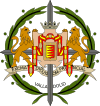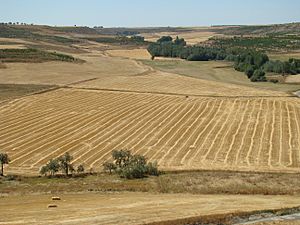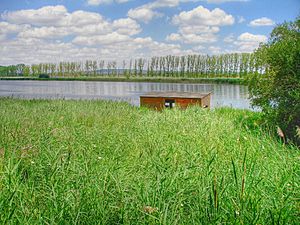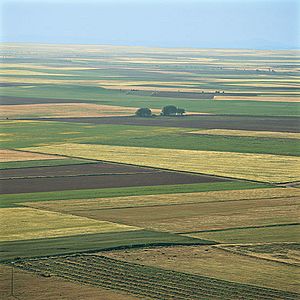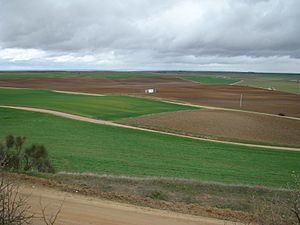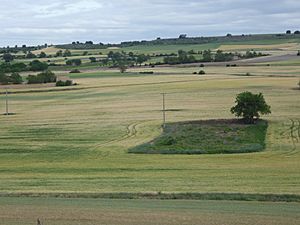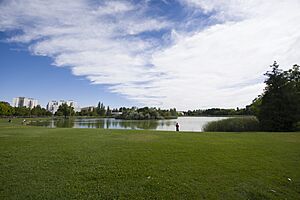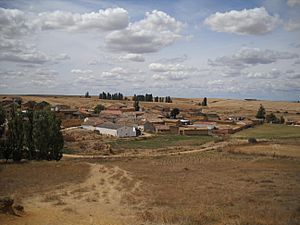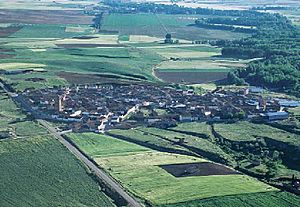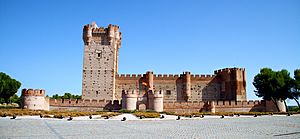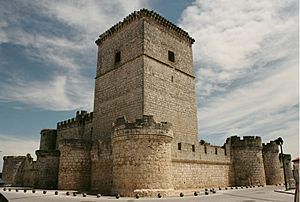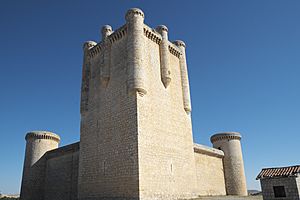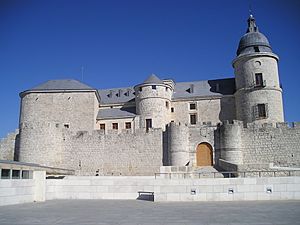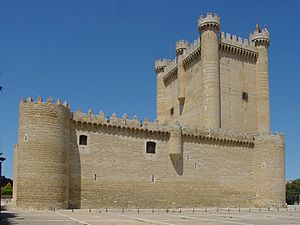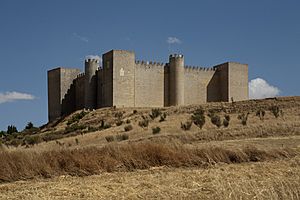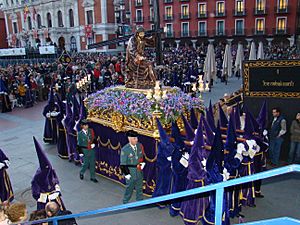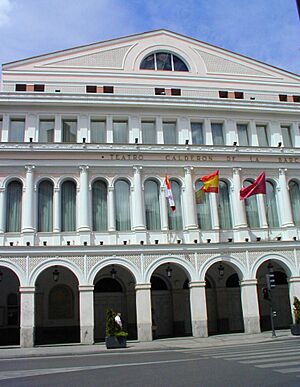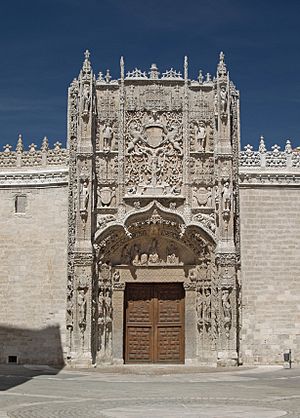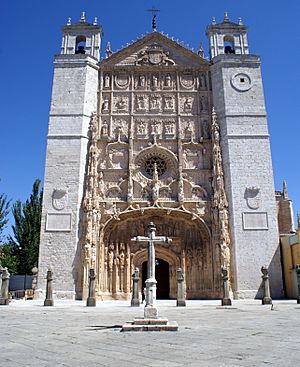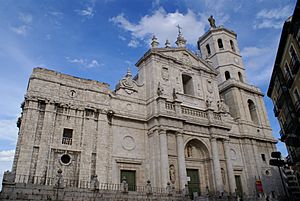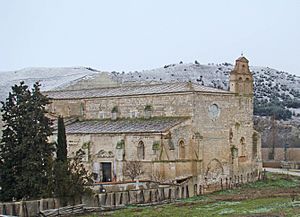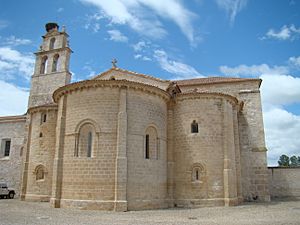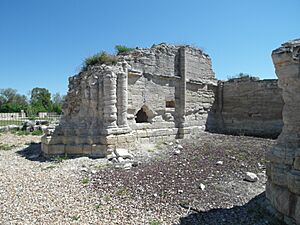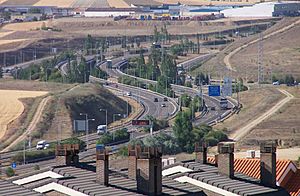Province of Valladolid facts for kids
Quick facts for kids
Valladolid
|
|||
|---|---|---|---|
      
From top to bottom and from left to right: The Castle of Peñafiel, Canal of Castile, typical landscape of the province, a pine forest, center of a Castilian town, Castle of La Mota and a wine cellar.
|
|||
|
|||
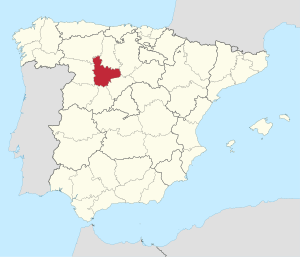
Map of Spain with Valladolid highlighted
|
|||
| Country | Spain | ||
| Autonomous community | Castile and León | ||
| Capital | Valladolid | ||
| Area | |||
| • Total | 8,110 km2 (3,130 sq mi) | ||
| Area rank | Ranked 28th | ||
| 1.61% of Spain | |||
| Population
(2015)
|
|||
| • Total | 526,223 | ||
| • Rank | Ranked 29th | ||
| • Density | 64.89/km2 (168.05/sq mi) | ||
| 1.14% of Spain | |||
| Demonym(s) | Spanish: Vallisoletano/a | ||
| Official language(s) | Spanish | ||
| Parliament | Cortes Generales | ||
| Website | diputaciondevalladolid.es | ||
Valladolid is a province in northwest Spain. It's located in the central part of the region called Castile and León.
About 526,000 people live here. The province has 225 towns and cities. The main city and capital is Valladolid.
The province shares borders with several other provinces. These include Zamora, León, Palencia, Burgos, Segovia, Ávila, and Salamanca.
Contents
History of Valladolid
Early Inhabitants
Long ago, a group of people called the Vaccaei lived here. They were the first known people to settle in the middle Duero River valley. They had a stable presence in this area.
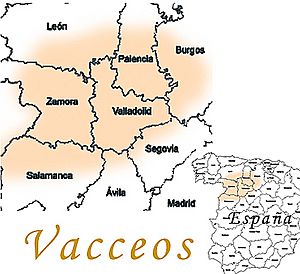
Important Historical Events
Valladolid has seen many important events. One was the Revolt of the Comuneros in 1521. This was a big uprising against the king.

Famous Explorers
Did you know a famous explorer came from here? Juan Ponce de León was born in Santervás de Campos. He was one of the first Europeans to explore Florida in what is now the United States. He even gave Florida its name!
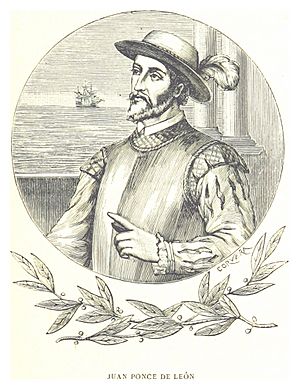
Geography and Nature
Landscape of Valladolid
The province of Valladolid has a typical landscape. You'll see many cultivated fields, especially those using the Open field system. There are also pine forests and beautiful natural areas.

Mountains and Rivers
The Torozos Mountains are a notable feature. In spring, they are especially green and lovely. The important Douro River also flows through the province.

Protected Natural Areas
Valladolid has one special protected area. It's called the Nature Reserve Banks of Castronuño-Vega del Duero. This reserve is a great place to see local wildlife and nature.
The Canal of Castile
The Canal of Castile is an old waterway. It was built a long time ago to help transport goods. Today, it's a historic landmark and a peaceful place to visit.
Economy and Agriculture
Farming in Valladolid
Farming is very important in Valladolid. The climate here means that Dryland farming is common. This type of farming relies on natural rainfall.

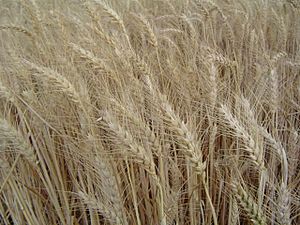
Farmers grow crops like barley, wheat, oats, and rye. You can see many cultivated fields across the province.
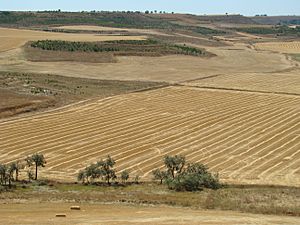
Wine Production
Valladolid is also known for its wine. There are many wineries here. Some wines from this area have a special quality mark called Ribera del Duero.
Industry and Cars
The province has an important industrial history. The first Renault 4CV car made by FASA-Renault in Spain was built here. This factory opened in 1951 and helped the area grow a lot.

Cities and Towns
The Capital City
Valladolid city is the capital and the largest city in the province. It has about 298,000 people. It's a lively place with lots to see and do.
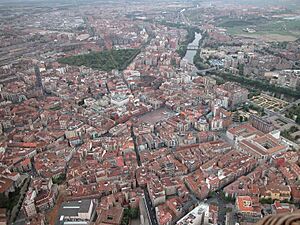
Other Important Towns
- Laguna de Duero: This is the second largest town, with over 22,000 people.
- Medina del Campo: This town is the third largest, with about 20,000 people.

Most of the 225 towns in the province are quite small.
Culture and Landmarks
Amazing Castles
Valladolid is famous for its many historic castles. They tell stories of knights and old kingdoms. Some of the most well-known castles include:
- Castle of La Mota
- Castle of Peñafiel
- Portillo Castle
- Castle of Torrelobatón
- Simancas Castle
- Castillo de Fuensaldaña
- Montealegre de Campos Castle
Medieval Towns
Urueña is a beautiful medieval town. It still has its old walls, making it feel like you've stepped back in time.
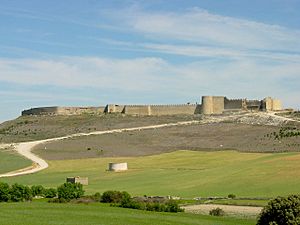
Delicious Food
When you visit Valladolid, you must try the local food! Roast lechazo (suckling lamb) and roast suckling pig are very popular dishes.
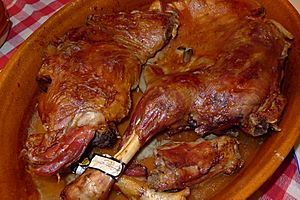
Festivals and Arts
- Holy Week: The Holy Week processions are a big event. People carry beautiful statues through the streets.
- Calderón Theatre: The Calderón Theatre is a famous place for performances. It's also the main spot for the seminci film festival.
- National Sculpture Museum: This museum in Valladolid has an amazing collection of sculptures.
Important Archives
The Archivo General de Simancas (General Archive of Simancas) holds very old and important documents. It's so special that UNESCO has recognized it as a World Heritage Site under its Memory of the World Programme. The Treaty of Tordesillas is one of the famous documents kept here.
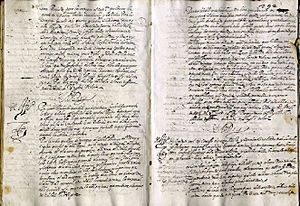
Sports
If you like football, you might know about Real Valladolid. This team plays its home games at the José Zorrilla Stadium.
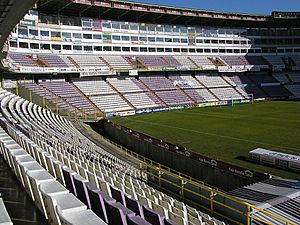
Architecture and Buildings
Valladolid has many beautiful old buildings, showing different styles of architecture through history.
Ancient Churches
- The Church of San Cipriano in San Cebrián de Mazote is a great example of pre-Romanesque style.
- The Church of Our Lady of the Announced in Urueña shows romanesque architecture.

Gothic and Renaissance Styles
- San Pablo Church in Valladolid is a stunning example of Gothic style.
- The Cathedral of Valladolid shows Renaissance style, especially the Herrerian design.
Baroque Architecture
The Church of Our Lady of the Assumption in Rueda is one of the best examples of baroque architecture in the area.
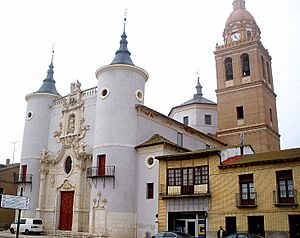
Historic Monasteries
The province is home to several old monasteries, each with its own history:
- Monastery of Santa María de Valbuena
- Monastery of Santa María de Palazuelos
- Monastery of Santa María de Retuerta
- Monastery of Santa Clara
- Monastery of Santa María de La Santa Espina
- Monastery of Santa María de Matallana
Transportation
Roads
The Autovía de Castilla is a major highway that connects Valladolid to other parts of Spain.
Trains
Valladolid has a train station called Valladolid-Campo Grande. You can catch high-speed trains (like the AVE) here.
Airport
The Valladolid Airport helps people travel by air to and from the province.
Images for kids
-
Climograph of Valladolid.
See also
 In Spanish: Provincia de Valladolid para niños
In Spanish: Provincia de Valladolid para niños



